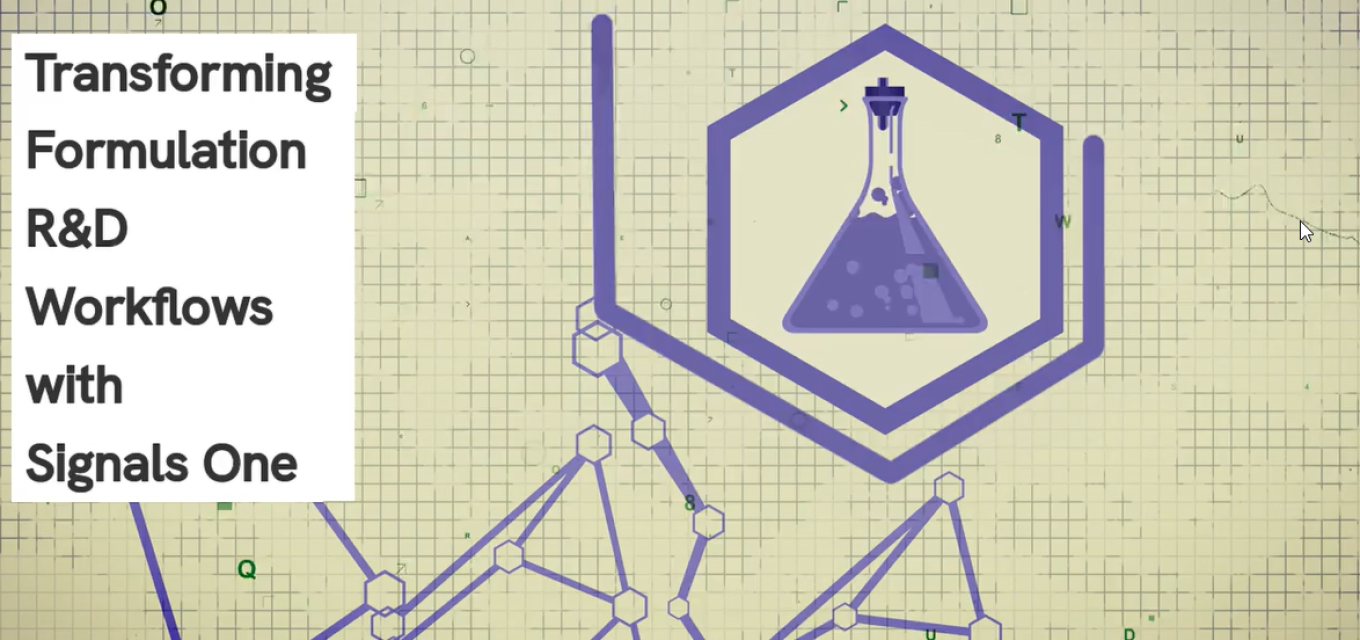Transforming Formulation R&D Workflows with Signals One
Formulation is critical across materials science, food science, and related industries, requiring precise and comprehensive experimentation to determine optimal ingredients, proportions, and processes for new materials and products. Yet many organizations struggle to improve efficiency in formulation science. Inconsistent data capture hinders the data aggregation necessary for comprehensive analysis. Data sharing is cumbersome, limiting cross-team collaboration thus knowledge exchange. Information lies in silos, limiting visibility into better product design.
One addresses these challenges by streamlining formulation science workflows from research to execution, ensuring structured and systematic data capture, facilitating collaboration, and providing analytical tools to support data analytics and decision-making. The result is accelerated product development and greater R&D success.
Documenting Research with Both Structure and Flexibility
Signals Notebook (the data capture and collaboration capability of Signals One™), a cloud-native electronic laboratory notebook, enables formulation scientists to capture data accurately and consistently while retaining critical contextual information related to experiments. New projects can start from scratch or use organization-defined templates that indicate mandatory and optional fields. The platform generates meta-data and uniqueness identification information automatically, making the stored data easy to be searched even years later.
While templates ensure consistent data capture, the platform remains flexible to accommodate individual needs. Users can rename and reorder information in various formats, drag and drop multiple document types—including PDF instrument reports and photos of experimental setups or material produced—and integrate with Microsoft Office applications. The native ChemDraw integration in Signals One, provides chemical intelligence directly within experiment records.
Formulation Science Workflows with Excel-like Calculations
Signals Notebook offers specialized functions for formulation science, including an ever-expanding library of calculations, unit conversion functions, statistical analysis tools, user-friendly data-table manipulation tools, and secure information indexing and data linkage functions. Administrator-defined tables (ADT) facilitate tracking and calculating composition throughout experiments. Users can search ingredients from existing databases or create them manually, recording both planned quantities and actual measured mass.
Tracking Batches and Samples with Ease
Formulation scientists frequently create multiple batches in parallel, varying composition, process parameters, or raw material sources. Signals Notebook’s variations tables capability supports these workflows by allowing users to define base components and then describe variances across individual batches. Summary views and sorting functionality help scientists compare formulations in different ways.
Defining Formulations for Downstream R&D Workflow
For downstream applications requiring consistent processes, formulation tables can be embedded into worksheets. Administrators can define these to include both procedural information and structured composition data in one unified system. Formulation teams can use the task function to prepare and monitor, ensuring sample and inventory information is tracked and updated. All this data is captured in the background for project review and audit when necessary.
Gaining Insights from Data to Improve Formulation
The benefits of Signals One extend far beyond facilitating experimental workflows. By ensuring structured data capture, Signals One enables data aggregation and effective analysis.
With the aggregate data tables and analysis tools built-in, scientists and project leads can compare broad sets of formulations to understand relationships between compositions and new product performance. This data-driven formulation approach helps determine which parameters to vary in subsequent experiments, identify patterns that suggest new compositions, and recognize promising candidates for further testing.
The systematic data capture and simplified visualization improves decision making, helping teams enhance product performance and reduce development timelines.
Facilitating Collaboration and Knowledge Exchange
Developing new chemistry and food products requires collaboration between multidisciplinary teams. As a cloud-native SaaS R&D solution, Signals One provides access from authorized devices anywhere. Users can view data across experiments, notebooks, projects, and locations based on organization-defined data security rules. Scientists can tag colleagues for input, who receive notifications with direct links to relevant experiments.
Data analysis tools are accessible to team members, democratizing insights and advancing collaborative data exploration, empowering researchers throughout the entire product development cycle.
Accelerating Innovation through Data-Driven Formulation
Signals One represents a transformative solution for formulation R&D workflows, addressing the critical challenges of data structure consistency, cross-team collaboration, and systematic data capture that have traditionally hindered efficiency in this field. By providing both structured templates and flexible configuration, the platform ensures that formulation scientists can document their research with precision while adapting to specific project needs.
The solution's data management capabilities—from composition calculations to variations tables for parallel experimentation—directly address the unique requirements of formulation science. By streamlining these processes, Signals One enables scientists to focus on innovation.
Perhaps most importantly, the data-driven formulation approach facilitated by Signals One transforms how organizations derive insights from their research. By aggregating structured data across experiments, teams can more easily identify patterns, optimize formulations, and make informed decisions about which compositions warrant further development. This systematic approach to data management and analysis accelerates development timelines and improves product performance outcomes.
As formulation science continues to evolve across industries—from pharmaceuticals to paints, coatings, and beyond—solutions like Signals One will play an increasingly vital role in helping organizations maintain competitive advantage through more efficient, collaborative, and data-informed research processes.
Interested to learn more? Explore Signals One.
Related Articles
Unlocking Insights Through Data: Digital Transformation in Formulation Science - Revvity Signals
The State of Digital Transformation in the Specialty Chemicals Industry - Revvity Signals

Jun Liu
Product Marketing Lead, Industrial Chemistry, Revvity SignalsJun Liu is a product marketing lead responsible for Industrial Chemistry segment marketing activities at Revvity Signals. Jun has over 10 years of marketing and business development experience in the Specialty Chemical industry and worked as a software engineer in the semi-conductor industry. He has an MBA degree and an MS in Electrical Engineering from the University of Texas at Austin, also holds a BS in Computer Engineering from Michigan Technology University.
